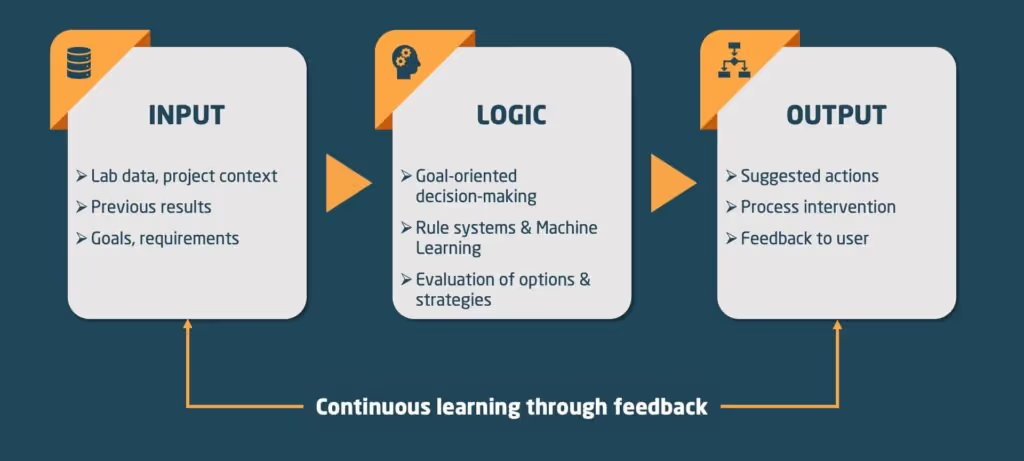AI agents
AI agents are gaining ground fast — transforming how decisions are made across industries. But what happens when they enter R&D and QA environments? With access to clean data and clear goals, these proactive systems can analyze, decide, and suggest — accelerating innovation and enhancing quality. The result? Smarter labs, faster cycles, and data-driven breakthroughs.
Why AI Agents Are Gaining Relevance Now?
AI agents are considered a key developmental path within the next wave of technology. According to the research and advisory firm Gartner, by 2028, around 15% of all business decisions will be influenced by agent-based systems (report). IBM also sees the concept of “Agentic AI” as marking a new phase in intelligent automation. The maturity of the technology, growing availability of data, and powerful cloud infrastructures are, for the first time, creating the necessary conditions for real-world deployment — including in industrial environments, as described in a trend report by IBM.
These technological advances open up entirely new opportunities in lab environments: processes can be optimized based on data, innovation accelerated, and quality assurance made smarter.
What Are AI Agents?
An AI agent is an intelligent software program that independently pursues goals, analyzes data, prepares decisions, and derives concrete action proposals or initiates process interventions.
Unlike traditional AI systems, which mostly operate reactively and respond to specific queries, agents act proactively: they recognize what needs to be done and work toward achieving the defined goal efficiently.
To do this, they rely on three core elements:
- Input: The agent processes structured input data — such as lab data, project context, previous results, or clearly defined requirements.
- Logic: Using decision rules, machine learning, or heuristics, the agent evaluates different options and selects the most suitable strategy.
- Output: The result is a set of proposed actions, automated recommendations, or direct process interventions — which are returned to humans for review and decision-making.

A key feature of agents is their ability to learn continuously through feedback: they analyze which suggestions were implemented and how successful they were -and use this to refine their decision logic.
In lab environments, this marks a significant advancement. AI agents help not only to manage material data but to use it intelligently – enabling more informed decisions, shorter development cycles, and more efficient quality assurance. For example, if a customer requires a new coating for high-temperature applications, the agent can analyze historical formulations, requirements, and test results – and suggest a suitable combination that meets all relevant conditions within a short time.
How Do AI Agents Work?
An AI agent processes information in three steps:
– First, it requires structured, digitally available data. Typical sources include LIMS systems, ERP databases, Excel sheets, or specialized material intelligence platforms such as LabV. Relevant data may include formulations, material properties, process parameters, or test results.
– In the second step, the agent identifies defined goals, searches for patterns in the available data, evaluates correlations, and generates concrete suggestions based on its decision logic.
– In the third step, the results are presented: the agent provides actionable recommendations, optimized formulations, test plans, or alerts in case of deviations. Importantly, the human remains the final decision-maker who reviews and validates the agent’s output.
Practical Examples
R&D Coating Development: From Historical Knowledge to New Formulations
A client in the coatings industry requested a solution for use under extreme environmental conditions. Instead of relying on traditional trial-and-error methods, a lab deployed an AI agent.
The process:
- Analyze historical data: The agent reviewed past formulations and test results under similar conditions.
- Integrate constraints: Requirements such as temperature resistance, adhesion, and regulatory compliance were factored in.
- Generate recommendations: The agent developed optimized formulations and provided reasoning for its suggestions.
- Selection and refinement: The final choice was made by humans, who guided additional adjustments based on feedback.
The result: development time was significantly reduced, resources were used more efficiently, and the likelihood of success increased. Detailed insights into this use case and additional examples can be found in the white paper (read more).
Quality Assurance for Recyclates: Early Detection of Deviations
AI agents also proved effective in supporting quality assurance for recyclates. Material variations could be detected early and adjusted proactively.
The process:
- Review input data: The agent analyzed incoming material batches and compared them with historical quality data.
- Identify anomalies: Deviations from defined quality standards were detected automatically.
- Derive recommendations: The agent proposed adjustments such as blending with virgin material or modifying process parameters.
- Integrate feedback: QA engineers reviewed the suggestions, allowing the agent to improve based on the outcomes.
The result: material quality was stabilized, rejection rates reduced, and inspection efforts lowered. A detailed description of this application scenario is available in our case study — including data structures, day-to-day challenges, and key lessons learned from implementation (read more).
Requirements and Limitations
To unleash their full potential, AI agents require certain preconditions. Most importantly, a structured and digitally available data foundation is essential. Without high-quality input data, agents cannot generate reliable analyses or recommendations.
Equally important are clearly defined goals. The agent must know what it’s aiming to achieve — whether it’s optimizing a formulation or identifying quality deviations.
Feedback mechanisms are another key success factor. Only when suggestions are reviewed and responses systematically integrated can the agent learn and improve over time.
Finally, the human remains the ultimate authority. The agent provides suggestions — responsibility stays with people. In this sense, agents are tools, not substitutes. Their strength lies in how they complement human expertise.
Conclusion: Why Connected Data Matters Now?
AI agents won’t transform everyday lab work overnight — but they do open up new opportunities for data-driven decision-making. The foundation must be laid today: clean data structures, interconnected systems, and a thoughtful approach to digital knowledge.
Those who begin now to consistently capture, connect, and utilize their material data digitally are creating the conditions for the next step: the targeted use of intelligent agents. These can then automate processes, deliver recommendations, or prepare decisions — embedded in a system that is understood and supported by its users. We explore the associated opportunities, challenges, and real-world use cases in greater depth in our webinar “AI Agents in the Lab: Assistance Systems for R&D and QA.”
The first step isn’t the agent technology itself — it’s the strategic decision to use data effectively. That’s where labs and companies should focus today if they want to fully benefit from future developments in artificial intelligence.
